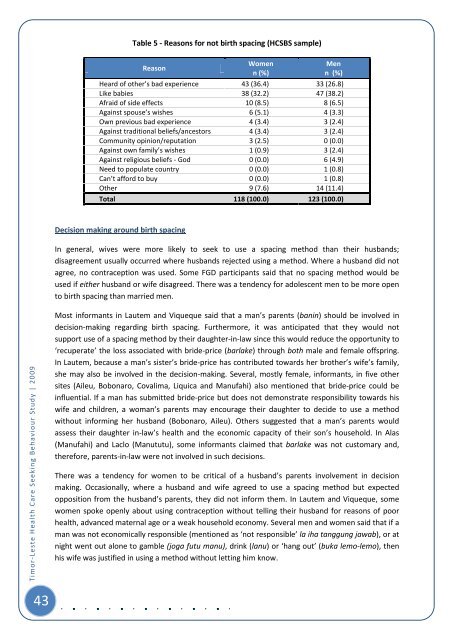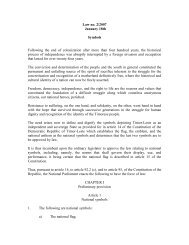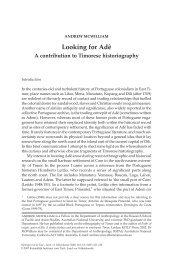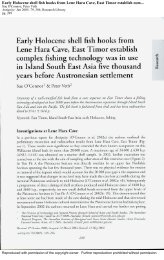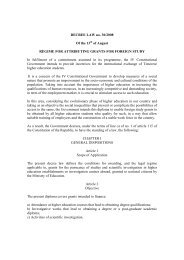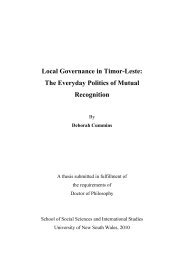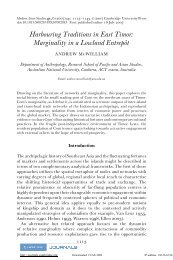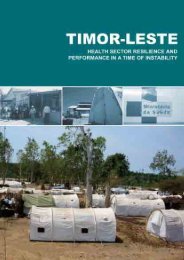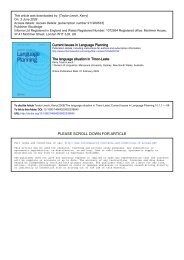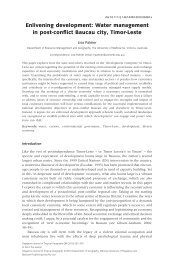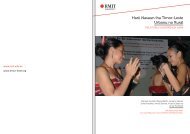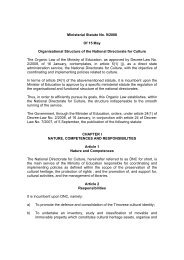Table 5 - Reasons for not birth spacing (HCSBS sample)ReasonWomenn (%)Menn (%)Heard of other’s bad experience 43 (36.4) 33 (26.8)Like babies 38 (32.2) 47 (38.2)Afraid of si<strong>de</strong> effects 10 (8.5) 8 (6.5)Against spouse’s wishes 6 (5.1) 4 (3.3)Own previous bad experience 4 (3.4) 3 (2.4)Against traditional beliefs/ancestors 4 (3.4) 3 (2.4)Community opinion/reputation 3 (2.5) 0 (0.0)Against own family’s wishes 1 (0.9) 3 (2.4)Against religious beliefs - God 0 (0.0) 6 (4.9)Need to populate country 0 (0.0) 1 (0.8)Can’t afford to buy 0 (0.0) 1 (0.8)Other 9 (7.6) 14 (11.4)Total 118 (100.0) 123 (100.0)Decision making around birth spacingIn general, wives were more likely to seek to use a spacing method than their husbands;disagreement usually occurred where husbands rejected using a method. Where a husband did notagree, no contraception was used. Some FGD participants said that no spacing method would beused if either husband or wife disagreed. There was a ten<strong>de</strong>ncy for adolescent men to be more opento birth spacing than married men.<strong>Timor</strong>-<strong>Leste</strong> <strong>Health</strong> <strong>Care</strong> <strong>Seeking</strong> <strong>Behaviour</strong> <strong>Study</strong> | 2009Most informants in Lautem and Viqueque said that a man’s parents (banin) should be involved in<strong>de</strong>cision-making regarding birth spacing. Furthermore, it was anticipated that they would notsupport use of a spacing method by their daughter-in-law since this would reduce the opportunity to‘recuperate’ the loss associated with bri<strong>de</strong>-price (barlake) through both male and female offspring.In Lautem, because a man’s sister’s bri<strong>de</strong>-price has contributed towards her brother’s wife’s family,she may also be involved in the <strong>de</strong>cision-making. Several, mostly female, informants, in five othersites (Aileu, Bobonaro, Covalima, Liquica and Manufahi) also mentioned that bri<strong>de</strong>-price could beinfluential. If a man has submitted bri<strong>de</strong>-price but does not <strong>de</strong>monstrate responsibility towards hiswife and children, a woman’s parents may encourage their daughter to <strong>de</strong>ci<strong>de</strong> to use a methodwithout informing her husband (Bobonaro, Aileu). Others suggested that a man’s parents wouldassess their daughter in-law’s health and the economic capacity of their son’s household. In Alas(Manufahi) and Laclo (Manututu), some informants claimed that barlake was not customary and,therefore, parents-in-law were not involved in such <strong>de</strong>cisions.There was a ten<strong>de</strong>ncy for women to be critical of a husband’s parents involvement in <strong>de</strong>cisionmaking. Occasionally, where a husband and wife agreed to use a spacing method but expectedopposition from the husband’s parents, they did not inform them. In Lautem and Viqueque, somewomen spoke openly about using contraception without telling their husband for reasons of poorhealth, advanced maternal age or a weak household economy. Several men and women said that if aman was not economically responsible (mentioned as ‘not responsible’ la iha tanggung jawab), or atnight went out alone to gamble (joga futu manu), drink (lanu) or ‘hang out’ (buka lemo-lemo), thenhis wife was justified in using a method without letting him know.43
Most informants referred to the norm that husband and wife ought to come to an agreement andshould share the same position (liafuan ida <strong>de</strong>it). Both men and women indicated that while womenshould follow their husband’s position, this could lead to un<strong>de</strong>rlying discord, e.g. ‘the woman followsthe man because the man does not want [to use a method] so the woman just follows [but] theproblem remains’. 18 Discord may result in husband and wife physically beating each other (bakumalu), infi<strong>de</strong>lity (selingkuh) by either partner but usually the male, divorce and/or the husbandtaking a new wife. 19Some informants felt the matter of discord was a secret (segredu), something that <strong>de</strong>monstratedweakness (kelemahan) or was a source of shame/embarrassment (moe) and, therefore, should notto be shared with family members as other people could not be relied on to keep this secret. Someclaimed that they would seek assistance from a ‘local authority’; others said that the husband’sparents, or both sets of parents, should be involved in discussing and resolving the problem as it wasa matter related to custom.Reasons for birth spacingThe scenario in the HCSBS FGDs related to ‘spacing’ (fo spasu) and not ‘family planning’ (KB ).However, participants ten<strong>de</strong>d to use the term KB to cover both practices: some using it to refer tospacing between children, others referring to stopping rather than spacing, e.g. saying they woulduse contraception when they had reached their <strong>de</strong>sired family size.20<strong>Health</strong>-related reasons mentioned for not using any spacing or family planning method focused onbleeding: heavy bleeding21 that caused extreme weakness, frequent menstruation, clotting (kafuak),no menstruation perceived to result in blood rising to the head and causing headaches. Severalinformants, male and female, mentioned that using spacing or KB could result in being unable toconceive or subsequent miscarriage. 22 It was said to be safer to use family planning after severalchildren in case it affected conception. Another reason for not using was <strong>de</strong>sire for more children,possibly <strong>de</strong>termined by <strong>de</strong>sired sex ratio; for example, at least one female child to bring bri<strong>de</strong>-price(Lautem), or sons to carry on the family name, inherit wealth (riku soin) or look after the ritual house(uma lulik).Factors of time and household economy influenced <strong>de</strong>cisions regarding spacing. Spaced childrenallow mothers time to attend to the needs of existing young children (e.g. feeding, dressing andclothing, bathing, schooling, taking care when they are crying or ill, and keeping children free ofsickness and healthy weight) and the needs of the household (e.g. carting water, procuring food,washing clothes, sweeping). Where spacing has been practiced, an ol<strong>de</strong>r child is capable of assistingits mother, otherwise a woman consi<strong>de</strong>rs herself to be alone (mesak), as her husband is absentduring the day and all children are as yet too young to assist. Spaced children allowed women to‘work’ (servisu) such as picking coffee that generated income. Many mentioned the importance ofbeing able to afford to educate existing children to provi<strong>de</strong> for their future.18 ‘Feto tuir mane tamba mane lakohi feto mak ba <strong>de</strong>it nee problema sei iha’ (Adolescent male, FGD Aileu).19 Taking a new wife and/or divorce was commonly mentioned as a normative response in Lautem and Viqueque.20 Acronym in Bahasa Indonesia for keluarga berencana, family planning, socialised in <strong>Timor</strong>-<strong>Leste</strong> by the Indonesianadministration.21 A married woman from Bobonaro claimed that the local priest informed his congregation that women may use a methodand sud<strong>de</strong>nly experience haemorrhage (raan fakar). Scant reference was ma<strong>de</strong> to the church in terms of people’s <strong>de</strong>cisionnot to use contraception: one person mentioned kelonggaran meaning transgression in the context of the church; anothersaid that fertility was the right (direitu) or plan (planu) of God.22 A male respon<strong>de</strong>nt stated that using traditional medicine as mo<strong>de</strong>rn contraception caused infertility (Covalima).<strong>Timor</strong>-<strong>Leste</strong> <strong>Health</strong> <strong>Care</strong> <strong>Seeking</strong> <strong>Behaviour</strong> <strong>Study</strong> | 200944


